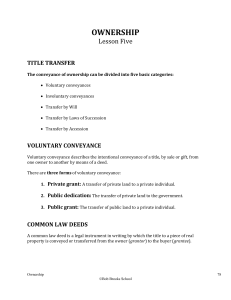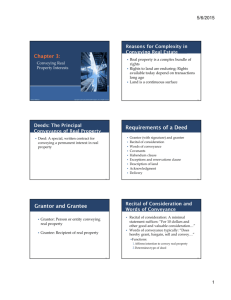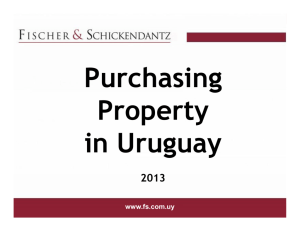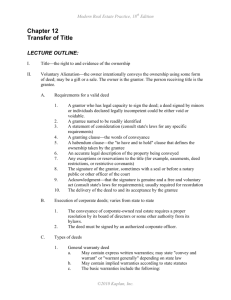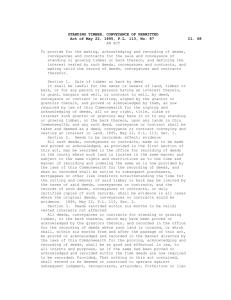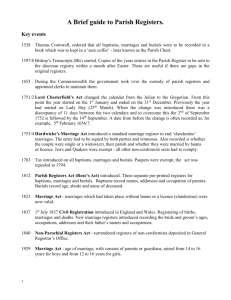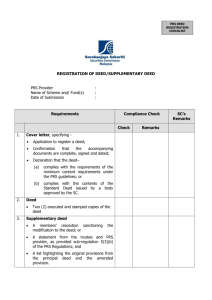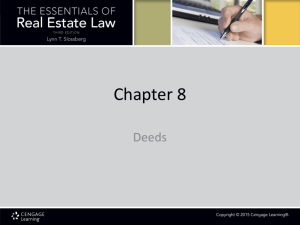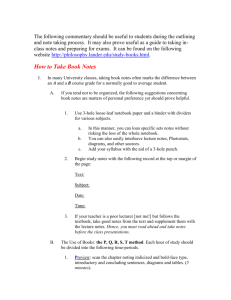FIN 331 Chapter 3
advertisement
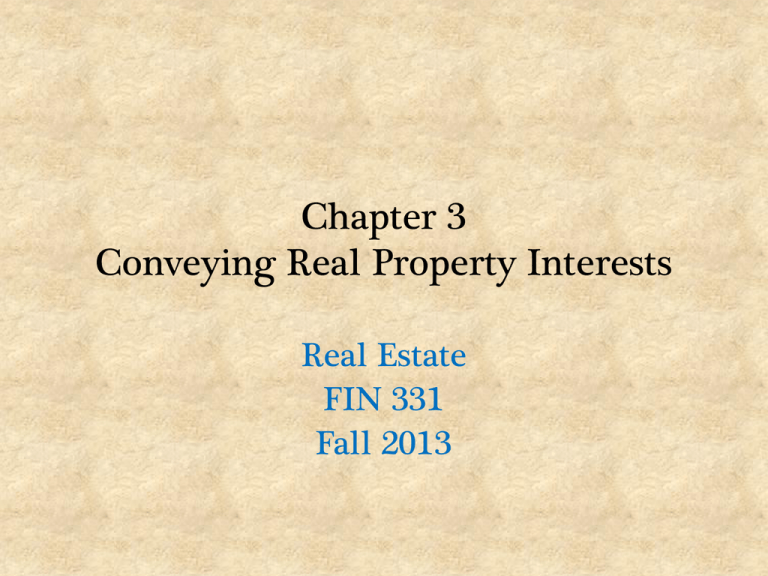
Chapter 3 Conveying Real Property Interests Real Estate FIN 331 Fall 2013 SOURCES OF COMPLEXITY IN CONVEYING REAL PROPERTY A. Real property is a complex bundle of rights B. Rights to land are enduring: Rights available today depend on transactions long ago C. Land is a continuous surface a. Boundaries not obvious or natural b. Boundary errors always hurt someone DEEDS – CONVEYING REAL PROPERTY A. Deed: A special, written contract for conveying a permanent interest in real property B. Requirements for a Deed 1. Grantor (with signature) and grantee grantor must be of legal age and competent 2. 3. 4. Recital of consideration: “for [ten] dollars and other good and valuable consideration…” Words of conveyance: “does hereby grant, bargain, sell, and convey unto…” Covenants a. Covenant of seizin: promise that grantor truly has good title and right convey it b. Covenant against encumbrances: no liens, easements, or other limitations except as noted in the date c. Covenant of quiet enjoyment: the premise that property cannot be claimed by someone else with a better title DEEDS – CONVEYING REAL PROPERTY 5. Habendum clause: defines or limits the type of interest being conveyed 6. Exceptions and reservations class (if any) 7. Description of land: legal descriptions are metes and bounds, subdivision plat and block number, in government rectangular survey 8. Acknowledgment 9. Delivery: a deed must be “delivered” in order to be valid TYPES OF DEEDS A. General warranty deed: All three covenants; seizin, no encumbrances, and quiet enjoyment B. Special warranty deed: identical to general warranty deed except as limited to the time of the grantor’s ownership C. Deed of bargain and sale: No covenants, but still is regarded as implying ownership D. Quitclaim deed: No covenants and makes no assertions about grantor’s interest TYPES OF DEEDS E. Judicial Deeds and Trustee’s Deeds 1. Judicial deeds are the result of a court ordered proceeding 2. Trustee’s deeds are issued by the trustee in a court supervised disposition of property Modes of Conveyance of Real Property A. Voluntary conveyance by deed 1. Ordinary sale and transfer of title B. Voluntary conveyance without a deed 1. Implied easement: utility easements 2. Easement by estoppel: permission to use by adjacent landholder 3. Dedication: When a developer dedicates street rights-of-way and open spaces Modes of Conveyance of Real Property C. Involuntary conveyance by deed 1. 2. 3. 4. 5. Probate (distribution of estate) Bankruptcy Divorce settlement Condemnation Foreclosure D. Involuntary conveyance without a Deed 1. Landowner involuntarily and unknowingly gives up rights to land 2. Easement by prescription 3. Title by adverse possession 4. Title by adverse possession Modes of Conveyance of Real Property E. Gain rights to land through the action of water (accretion, reliction) 1. Accretion: enlargement by natural action 2. Reliction: gradual change of water line on real property which gives the owner more dry land. Importance of Public Records A. Doctrine of constructive notice: Cannot be bound by claims or rules he or she has no means of knowing B. Statute of Frauds (1677): Contracts conveying a real property interest must be written to be enforceable C. Recording statutes: A contract recorded in public records is considered known D. Actual notice: Open, continuous, actual possession of property E. Public records provide information for a “Title” search Defining “Title” A. Title: Collection of evidence indicating a particular person(s) as holder of the “fee” B. Title search: Examining public records to construct “chain of title” C. Chain of title: the sequence of conveyances passing ownership down through time D. Evidence of Title 1. Title abstract together with an attorney’s opinion of title 2. Title insurance commitment 3. Title insurance protects the grantee against the legal costs of defending the title and against loss of the property in case of an unsuccessful defense Defining “Title” E. Potential Problems with Titles: (Motives for Title Insurance) 1. Conveyance of partial interest or adverse possession 2. Inconsistent property descriptions 3. Missing signatures 4. Faulty separation of mineral or water rights Land Descriptions A. Metes and Bounds 1. Metes refers to measures 2. Bounds refers to identifiable boundaries surrounding parcels of land B. Subdivision Plat Lot and Block Number C. Government Rectangular Survey: townships identified by range and tier lines HOMEWORK ASSIGNMENT A. Key terms: Accretion – Reliction, Adverse Possession, Covenant of Seizin, Types of Deeds (7), Doctrine of Constructive Notice, Easement by Estoppel, Encroachment, Habendum Clause, Metes and Bounds, Title Abstract / Insurance B. Study Questions: 1, 2, 4, 5 C. Issues to Ponder: Smith bought a repossessed property from the bank. A year later, Smith decides to have the property surveyed. Smith discovers that the adjoining neighbor’s fence is actually on Smith’s property. What are the issues involved?
